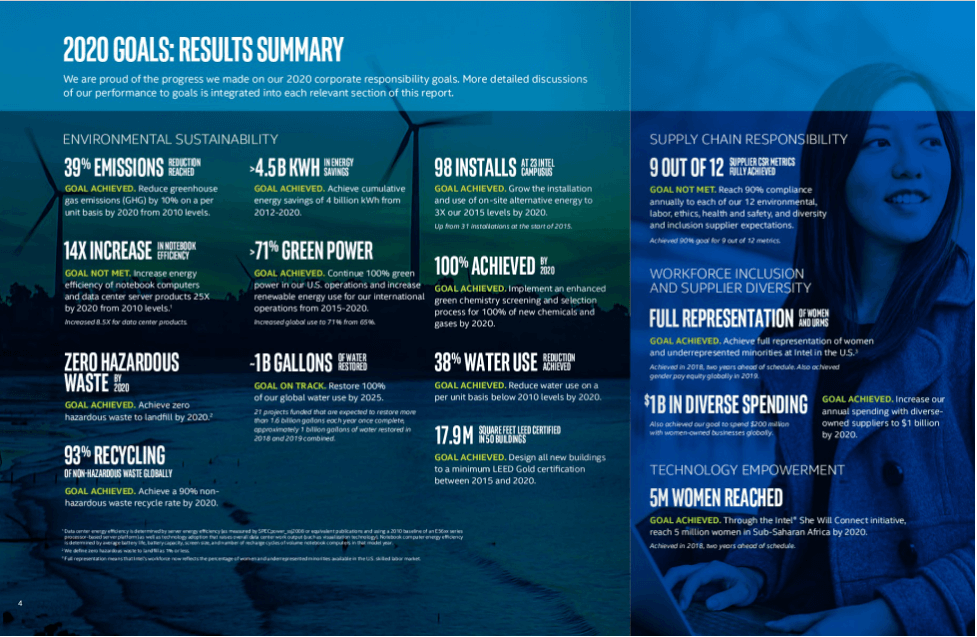Sustainability is one of today’s hottest topics in the news, and how to improve sustainability efforts is discussed at companies nearly on a daily basis. It seems only logical for 3D InCites to dedicate a blog to the topic of sustainability, as the semiconductor takes a more active stance, and most companies are putting sustainability policies in place. Some, like Lam Research, are taking it a step further with a focus on corporate social responsibility (CSR), which while includes sustainability also discusses other issues such as diversity, inclusion, and a responsible supply chain. While in the past, sustainability was rarely mentioned in semiconductor circles except at big events, it is starting to become a very serious issue to all parts of the semiconductor supply chain. As a result, we think it needs a bit of focus to see how companies are doing, what efforts they are making, and to celebrate the success that companies have in the sustainability area.
This new 3D InCites blog will focus on the semiconductor industry’s CSR efforts, with a focus on sustainability, such as the reduction of greenhouse gases, renewable energy utilization, improvements in equipment energy and water use, the reduction of water use, and improvements in the energy utilization of semiconductors, as they are employed in the AI space. Topics may expand into other areas such as the management of buildings to reduce energy using smart lighting, and other intelligent building practices. The goal is to both inform as well as to encourage the reader to improve both company and personal sustainability efforts. Let’s begin:
Global Sustainability Efforts
Since the Kyoto Protocol was adopted in 1997 and ratified in 2005, sustainability has been a much-discussed topic. In 2015-2016 with the adoption of the Paris Agreement, which is an update to the Kyoto Protocol, sustainability discussions and actions started to move forward with much more vigor. Even though the US administration in office from 2016-2020 withdrew from the agreement due to the amount the United States was financing it, as well as concerns about jobs for coal and oil companies; many US companies embraced the Paris Agreement and set-in place sustainability targets that are published either in annual reports or in a corporate social responsibility report (CSR). Based on the number of corporate announcements regarding the increased use of renewable energy to replace coal, oil, and natural gas as energy sources, this renewed effort is very visible. Moreover, with continued improvements in battery storage, the US continues to increase its use of renewables as a viable energy source.
Semiconductor Sustainability Efforts
Years ago, SEMI spearheaded environmental safety and health (ESH) safety standards for the industry, as well as restriction of hazardous substances (RoHS) efforts, and a green manufacturing committee. The organization also helped to coordinate efforts to reduced ozone-depleting gasses, back when the semiconductor industry used and released ozone-depleting gasses into the atmosphere. Techniques were developed to either find alternative gasses for use in the production facilities or methods to reduce the level of gasses released into the atmosphere.
At virtual SEMICON West 2020, SEMI focused several keynotes on sustainability, featuring first former Vice President Al Gore, followed by Gary Dickerson, of Applied Materials (AMAT) who laid out the company’s sustainability program for the future. According to Dickerson, AMAT will have 100% renewable energy sourcing in the U.S. by 2022 and worldwide by 2030, and a 50% reduction in Scope 1 and 2 carbon emissions by 2030. AMAT has several power purchase agreements where they expect to achieve 100% renewable sourcing in the United States and 73% worldwide by 2022. Dickerson also announced plans for a more sustainable supply chain, both from an energy and water perspective, as well as a materials responsibility perspective. On the surface a good concerted focused effort. On the Applied Materials website, they have CSR reports that date back to 2013. Read more: AMAT 2019 sustainability report.
While the Applied Materials press engine made a big announcement at SEMICON West, other companies in the semiconductor industry have been focused on sustainability for many years as well, some with a great deal of success. Lam Research has been publishing sustainability reports since 2013. The company set five-year goals in 2015 and achieved those targets in 2019.
Many semiconductor equipment companies such as Lam, ASML, Tokyo Electron (TEL), and AMAT are using the United Nations Sustainable Development Goals to help them set targets for future sustainability, as well as other social needs like diversity, hunger, and caring for the environment in other ways than just eliminating greenhouse gasses (Figure 1).

Most semiconductor equipment companies appear to be taking sustainability seriously and have programs to improve renewable power utilization, as well as to determine how to reduce power consumption and water usage in their equipment that they sell to semiconductor manufactures. The companies that have been surveyed to date are also exploring how to reduce greenhouse emissions from gases other than CO2. Two companies that have had concerted efforts without as much press as Applied Materials are, ASML which is a recent addition to the 2020 Dow Jones Sustainability Indices (DJSI), and TEL, which has already made the DJSI list. The Dow Jones Sustainability World Index tracks the performance of the top 10% of the 2,500 largest companies in the S&P Global Broad Market IndexSM that lead the field in terms of sustainability. 79 semiconductor companies were invited to participate in the survey (source SPG Global Invited Companies)
Semiconductor Companies are Leading the Way
From a semiconductor company perspective, Intel has been focused on sustainability efforts since before 2000 with efforts to conserve water at its New Mexico facility. In Intel’s 2020 Corporate Responsibility at Intel executive summary, the company reports it has saved 44 billion gallons of water in the past decade, along with 37 billion KWH of green power. By 2025 Intel expects to restore 100% of its water use.
While not solely one of the key drivers in the semiconductor equipment company’s efforts to jump on board the sustainability train, Intel has had a significant impact in moving sustainability forward. When most companies initiate a sustainability effort, they also incorporate their supply chain into the effort. Intel would not have been able to successfully reduce water consumption at Rio Rancho and worldwide without the participation of its key equipment vendors. In 2012, Intel introduced its Program to Accelerate Supplier Sustainability (PASS). The company completes on-site audits for its top 75 suppliers with assessments on 300 factors. In 2019 Intel aimed to have 90% of its suppliers in PASS meeting advanced expectations. These programs are likely part of a catalyst for many companies in the semiconductor manufacturing industry to have initiated their CSR programs, as most appear to have started the programs in the 2013-4 time.

Intel is not the only semiconductor company to have a strong focus on sustainability. TSMC, the industry’s largest foundry, also has embarked on a significant sustainable effort. TSMC’s sustainable goal for 2030 is to supply 25% of the power consumed by its fabrication plants from renewable energy, and 100% for other facilities’ power consumption. In July 2020, TSMC’s power purchasing agreements for renewable energy totaled 1.2 GW, and the company also officially passed the qualification to become the world’s first semiconductor company to join the RE100.
As a whole, semiconductor companies are making a concerted effort in the sustainability area. In the October 12, 2020, Wall Street Journal’s top 100 most sustainable companies, three semiconductor companies, and one equipment company are listed:
- 31 TI
- 48 Intel
- 66 Ebara
- 71 ST Microelectronics
This is a fairly significant achievement considering the WSJ looked at over 5500 companies in their study.
As mentioned above, the Dow Jones Sustainability Index (DJSI) monitors many companies’ worldwide using a rigorous methodology. Fifty-eight semiconductor-related companies were assessed in 2020. of those 58 companies, seven made the world-wide list, others made regional listing. ASML Holding NV was added in 2020 to the worldwide list. Other companies on the world-wide list areTSMC, UMC, Win Semiconductor, ASE Technology Holding Co., Infineon Technologies AG, and ST Microelectronics NV.
Companies that received a regional listing are Texas Instruments, SK Hynix, TEL, Micron, Nvidia, On-Semiconductor, and Intel. To get an apples-to-apples assessment of how companies are performing against one another from a sustainability perspective, it would be beneficial for them to participate with an organization that has a consistent methodology and ranking such as DJSI.
ASE is a DJSI World Leader
ASE has been on the DJSI as a world leader for the past five years; a considerable accomplishment, considering the other companies on the world-wide list from Taiwan. ASE has increased renewable electricity use in 2019 by 29% over 2018 and seven of its manufacturing sites have achieved over 100% renewable electricity usage. Water usage is down by 9% over 2018. ASE also participates in a reforestation project to assist in the mitigation of greenhouse gasses. Since 2017 27 hectares of land and 40,000 seedlings have been planted.
From the semiconductor industries’ participation in the DJSI, as well as the focus on corporate social responsibility in companies’ corporate reporting, it is apparent that semiconductor companies have taken their role in improving sustainability seriously. Even to the point where companies such as Intel are looking at how they can reduce the power consumption in processors, and equipment companies consider how to reduce water and power usage in process equipment. As semiconductor companies continue to set goals and plan it will be interesting to see how they continue to drive the needle in improving sustainability. ~ Dean



















